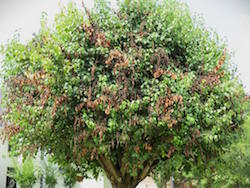
Fire blight is a bacterial disease that causes leaves and twigs on the ends of pear branches to die and turn brown.
June 24, 2024 - If you have grown pears before, you have surely noticed dead twigs, dead branches, and even entirely dead trees depending on the cultivar. During wet, disease-splashing years, fire blight is generally to blame.
According to our Fire Blight of Ornamental Pears publication by Shelia McBride and Dave Appel, fire blight causes vascular wilt in many varieties of pome trees (apples, pears, and ornamental pears) and other members of the rose (Rosaceae) family. This is perhaps our most important fruit family which also includes peaches, nectarines, plums, apricots, blackberries, and strawberries. With vascular wilt diseases, pathogens block the water-carrying (vascular) system of the plant, causing the leaves, stems, and branches to wither, weaken, and die. One of the most destructive diseases of commercial apples and pears, fire blight is also a serious disease of the popular ornamental Bradford pears used in many East Texas landscapes. Other common Texas woody ornamentals affected by fire blight are loquat, cotoneaster, and pyracantha.
Symptoms: Infected flowers become water-soaked (translucent and wilted), shrivel, and turn brown. Leaves progressively turn brown, develop black blotches, curl, and eventually shrivel. Twigs wilt from the tip downward, turning black and curling in a “shepherd’s crook,” giving them a burnt appearance. Branches develop dark, sunken cankers that enlarge and girdle the branches. Eventually, the whole branch can die.
Causes and Environmental Factors: The bacterium, Erwinia amylovora, causes fire blight. The pathogen over-winters in cankers, bud scars, and branches; forms an ooze that attracts insects, including bees, that then spread the bacteria via the nectarthodes (openings at the base of flowers); also spreads by rain, which splashes onto the bacterial ooze and causes new infections; and infects new, tender, succulent twigs and leaves.
Control: During winter dormancy, use sanitation pruning to remove infected wood. Cut an infected branch 4 to 6 inches below the visible injury or canker. To avoid spreading bacteria during pruning, sanitize the pruning tool before each cut, using a 10-percent bleach solution (one part bleach to nine parts water). To prevent rust, dry and oil your tools after using them.
Reduce excessive succulence by avoiding extreme fertilization and watering. Plant resistant varieties. When possible, reduce new infections by spraying an antibiotic such as streptomycin sulfate (Fertilome® Fire Blight Spray) on flowers or shoots before the bacteria infect them. A copper sulfate fungicide (Bonide® Copper Fungicide) is also an option when applied several times while the blossoms are open. (Neither option will eliminate all new infections or those already existing in the wood.) Refer to product labels for proper rates and use.
Although fire blight can kill susceptible soft pear cultivars such as ‘Barlett’ (European types are especially susceptible) it only temporarily mars the appearance of ‘Bradford’ and other ornamental cultivars of Pryus calleryana, a more resistant species. I personally would not take the time or expense to spray any pear cultivars and would rely on resistant cultivars, sanitation, and proper culture.
For additional information visit the Texas A&M AgriLife Extension Service Texas Plant Disease Diagnostic Lab website at https://plantclinic.tamu.edu/ or follow them on Facebook at “Texas Plant Disease Diagnostic Lab.” You can also read more about blight resistant pears in the “Pears” publication on the Aggie Horticulture website under the Fruit and Nut Resources tab.
Greg Grant is the Smith County horticulturist and Master Gardener coordinator for the Texas A&M AgriLife Extension Service. He is the author of Texas Fruit and Vegetable Gardening, Texas Home Landscaping, Heirloom Gardening in the South, and The Rose Rustlers. You can read his “Greg’s Ramblings” blog at arborgate.com, read his “In Greg’s Garden” in each issue of Texas Gardener magazine (texasgardener.com), or follow him on Facebook at “Greg Grant Gardens.” More science-based lawn and gardening information from the Texas A&M AgriLife Extension Service can be found at aggieturf.tamu.edu and aggie-horticulture.tamu.edu.








